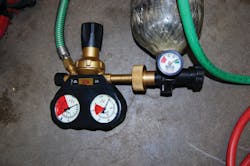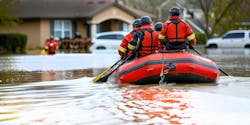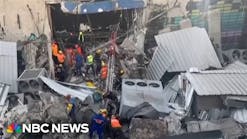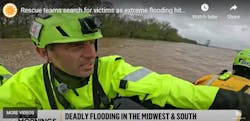Air bags are not pieces of equipment that are used every day, but if a victim is pinned underneath a heavy object, air bags are often the preferred option for freeing them. It is essential for members to understand the limitations of air bag use and to be proficient in operating procedures, so airbags can be quickly and safely placed into operation.
Air bags can be used in a variety of incidents including building collapses, heavy extrications and industrial entrapments. The most common situations involve: pedestrians/bicyclists who are pinned during an accident; partially ejected motorists with trapped extremities; victims caught underneath vehicles as a result of jacks slipping; and workers involved in various construction site accidents. Air bags can be adapted for many other situations such as to displace, spread or otherwise move objects. You are limited only by your imagination for the number of situations in which air bags can be used.
Air-Bag Classifications
Air bags are generally classified into low pressure or high pressure. Low-pressure air bags typically operate at 7 to 14 pounds per square inch (psi). These bags spread their pressure over the surface of the object to reduce the potential for damage. Low-pressure bags are designed for higher lift heights with lower tonnage capacity.
This series of articles will be focusing on high-pressure air bags, which usually range in operating pressures from 100 psi to 200 psi depending on the manufacturer. High-pressure bags are designed for lower lift heights with higher tonnage capacity. Each bag has a maximum lift capacity, listed in tons, and a maximum lift height. These topics will be discussed in greater detail in future articles.
Air-Bag System Components
The air-bag system consists of several components including: an air supply, regulator, hoses, controller, remote shutoff valves and air bags. The standard air supply is an SCBA (self-contained breathing apparatus) cylinder, but it can also be supplied by other air sources including the air system on the apparatus. SCBA cylinders are ideal because they can easily be transported to remote rescue areas.
Attached to the air supply is a pressure regulator that has high- and low-pressure gauges (photo 1). The high-pressure gauge reads the pressure in the air supply (i.e. 4,500 psi in a high-pressure SCBA cylinder). The low-pressure gauge reads what the pressure is being reduced to by the regulator. The regulator has a control knob that is used to increase or decrease the pressure that is being supplied to the rest of the system. The pressure is usually set between 116 psi and 145 psi, depending on the manufacturer’s recommendations. It is important that the pressure is dialed down when the system is being stored as the gauge utilizes a tensioned spring that can wear out if kept dialed up. This constant tension on the spring can make it impossible to increase the pressure to the necessary output required to operate the system.
The controller is attached to the regulator via a short hose (photo 2), and it controls the airflow into or out of the air bags. Manufacturers produce controllers to operate either one or two air bags. Controllers are equipped with low-pressure gauges and relief valves for each air outlet. The relief valve is designed to prevent the bags from being overinflated above their recommended operating pressure.
Airflow is controlled via dead man switches/buttons for both inflation and deflation. The dead man switch is designed to close the valve as soon as pressure is released from the button. This allows airflow to stop as soon as the operator releases pressure from the button.
Attached to the controller are pneumatic hoses that send the operating pressure to the desired air bags. Hoses are available in different lengths and colors from the manufacturer. It is important that the hoses are different colors for each air bag being used in the lift (photo 3). The operator of the controller may not be able to see the bags that he/she is controlling. By having different colored hoses the person calling the lift can tell the operator which color to inflate or deflate. More information on system setup and calling the lift will be covered in future articles.
Remote shutoffs or “pigtails” can be connected between the controller and the pneumatic hose or the pneumatic hose and the air bag (photo 4). These “pigtails” allow the operator to close a valve and disconnect the hose from the system without having air leak out of the bag. This is desirable when more than two bags are required to complete the lift. It is beneficial to have the remote shutoff located at the controller so members will not be placed in the hazard zone when switching hoses. The location of the shutoffs will depend on the manufacturer’s recommendations or your department’s standard operating procedures (SOPs).
The final part of the air-bag system is the air bags themselves. Each air bag is connected to the system via a nipple in one of the corners that controls the airflow into or out of the bag. Air bags are available in various sizes and capacities from the manufacturer. The bags are constructed of neoprene or butyl rubber that is reinforced with either steel wire or layers of Kevlar© Aramid© fiber. These reinforcing layers are designed to prevent the bag from being punctured.
Each air bag is stamped with its operating pressure and maximum lifting capacity (photo 5). Some bags are also stamped with their maximum lifting height. In addition, air bags have an “X” or some sort of mark to designate where the center of the bag is for lifting operations (photo 6). More on air-bag capacity and placement will be covered in future articles.
Conclusion
Members must be proficient at air bag operations to quickly and safely affect a rescue. If these types of operations are not safely performed they can result in the load shifting and/or dropping causing further injury or death to the victim or rescuers. Understanding the entire air-bag system and the science behind it is vital for a successful outcome.
For the full series of Air Bag Operations






